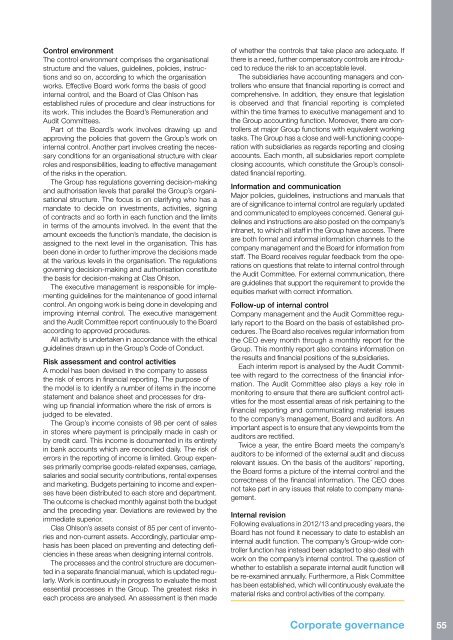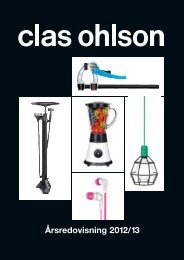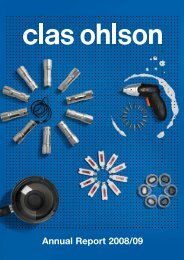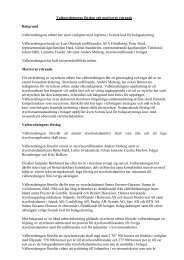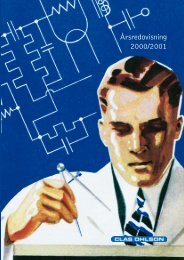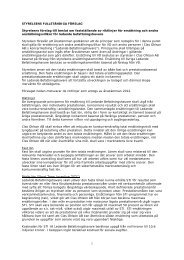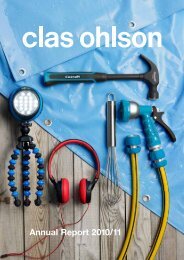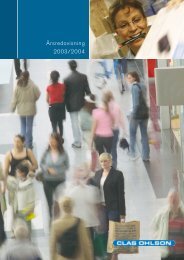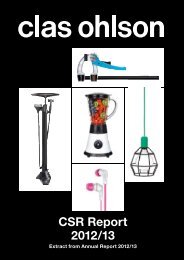Annual Report 2012/13 - Clas Ohlson
Annual Report 2012/13 - Clas Ohlson
Annual Report 2012/13 - Clas Ohlson
You also want an ePaper? Increase the reach of your titles
YUMPU automatically turns print PDFs into web optimized ePapers that Google loves.
Control environment<br />
The control environment comprises the organisational<br />
structure and the values, guidelines, policies, instructions<br />
and so on, according to which the organisation<br />
works. Effective Board work forms the basis of good<br />
internal control, and the Board of <strong>Clas</strong> <strong>Ohlson</strong> has<br />
established rules of procedure and clear instructions for<br />
its work. This includes the Board’s Remuneration and<br />
Audit Committees.<br />
Part of the Board’s work involves drawing up and<br />
approving the policies that govern the Group’s work on<br />
internal control. Another part involves creating the necessary<br />
conditions for an organisational structure with clear<br />
roles and responsibilities, leading to effective management<br />
of the risks in the operation.<br />
The Group has regulations governing decision-making<br />
and authorisation levels that parallel the Group’s organisational<br />
structure. The focus is on clarifying who has a<br />
mandate to decide on investments, activities, signing<br />
of contracts and so forth in each function and the limits<br />
in terms of the amounts involved. In the event that the<br />
amount exceeds the function’s mandate, the decision is<br />
assigned to the next level in the organisation. This has<br />
been done in order to further improve the decisions made<br />
at the various levels in the organisation. The regulations<br />
governing decision-making and authorisation constitute<br />
the basis for decision-making at <strong>Clas</strong> <strong>Ohlson</strong>.<br />
The executive management is responsible for implementing<br />
guidelines for the maintenance of good internal<br />
control. An ongoing work is being done in developing and<br />
improving internal control. The executive management<br />
and the Audit Committee report continuously to the Board<br />
according to approved procedures.<br />
All activity is undertaken in accordance with the ethical<br />
guidelines drawn up in the Group’s Code of Conduct.<br />
Risk assessment and control activities<br />
A model has been devised in the company to assess<br />
the risk of errors in financial reporting. The purpose of<br />
the model is to identify a number of items in the income<br />
statement and balance sheet and processes for drawing<br />
up financial information where the risk of errors is<br />
judged to be elevated.<br />
The Group’s income consists of 98 per cent of sales<br />
in stores where payment is principally made in cash or<br />
by credit card. This income is documented in its entirety<br />
in bank accounts which are reconciled daily. The risk of<br />
errors in the reporting of income is limited. Group expenses<br />
primarily comprise goods-related expenses, carriage,<br />
salaries and social security contributions, rental expenses<br />
and marketing. Budgets pertaining to income and expenses<br />
have been distributed to each store and department.<br />
The outcome is checked monthly against both the budget<br />
and the preceding year. Deviations are reviewed by the<br />
immediate superior.<br />
<strong>Clas</strong> <strong>Ohlson</strong>’s assets consist of 85 per cent of inventories<br />
and non-current assets. Accordingly, particular emphasis<br />
has been placed on preventing and detecting deficiencies<br />
in these areas when designing internal controls.<br />
The processes and the control structure are documented<br />
in a separate financial manual, which is updated regularly.<br />
Work is continuously in progress to evaluate the most<br />
essential processes in the Group. The greatest risks in<br />
each process are analysed. An assessment is then made<br />
of whether the controls that take place are adequate. If<br />
there is a need, further compensatory controls are introduced<br />
to reduce the risk to an acceptable level.<br />
The subsidiaries have accounting managers and controllers<br />
who ensure that financial reporting is correct and<br />
comprehensive. In addition, they ensure that legislation<br />
is observed and that financial reporting is completed<br />
within the time frames to executive management and to<br />
the Group accounting function. Moreover, there are controllers<br />
at major Group functions with equivalent working<br />
tasks. The Group has a close and well-functioning cooperation<br />
with subsidiaries as regards reporting and closing<br />
accounts. Each month, all subsidiaries report complete<br />
closing accounts, which constitute the Group’s consolidated<br />
financial reporting.<br />
Information and communication<br />
Major policies, guidelines, instructions and manuals that<br />
are of significance to internal control are regularly updated<br />
and communicated to employees concerned. General guidelines<br />
and instructions are also posted on the company’s<br />
intranet, to which all staff in the Group have access. There<br />
are both formal and informal information channels to the<br />
company management and the Board for information from<br />
staff. The Board receives regular feedback from the operations<br />
on questions that relate to internal control through<br />
the Audit Committee. For external communication, there<br />
are guidelines that support the requirement to provide the<br />
equities market with correct information.<br />
Follow-up of internal control<br />
Company management and the Audit Committee regularly<br />
report to the Board on the basis of established procedures.<br />
The Board also receives regular information from<br />
the CEO every month through a monthly report for the<br />
Group. This monthly report also contains information on<br />
the results and financial positions of the subsidiaries.<br />
Each interim report is analysed by the Audit Committee<br />
with regard to the correctness of the financial information.<br />
The Audit Committee also plays a key role in<br />
monitoring to ensure that there are sufficient control activities<br />
for the most essential areas of risk pertaining to the<br />
financial reporting and communicating material issues<br />
to the company’s management, Board and auditors. An<br />
important aspect is to ensure that any viewpoints from the<br />
auditors are rectified.<br />
Twice a year, the entire Board meets the company’s<br />
auditors to be informed of the external audit and discuss<br />
relevant issues. On the basis of the auditors’ reporting,<br />
the Board forms a picture of the internal control and the<br />
correctness of the financial information. The CEO does<br />
not take part in any issues that relate to company management.<br />
Internal revision<br />
Following evaluations in <strong>2012</strong>/<strong>13</strong> and preceding years, the<br />
Board has not found it necessary to date to establish an<br />
internal audit function. The company’s Group-wide controller<br />
function has instead been adapted to also deal with<br />
work on the company’s internal control. The question of<br />
whether to establish a separate internal audit function will<br />
be re-examined annually. Furthermore, a Risk Committee<br />
has been established, which will continuously evaluate the<br />
material risks and control activities of the company.<br />
Corporate governance 55


